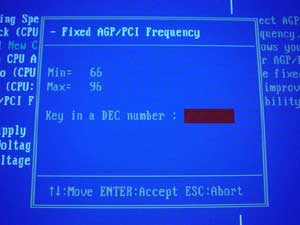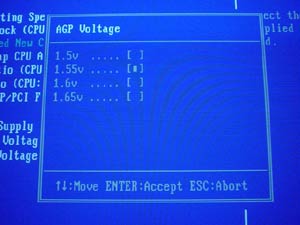ABIT IC7-G (875P): Challenging the Overclocking Throne
by Evan Lieb on May 21, 2003 12:04 AM EST- Posted in
- Motherboards
ABIT IC7-G: BIOS and Overclocking
As many enthusiasts know by now, ABIT currently uses their infamous Soft Menu III BIOS for all their high-end motherboards; this BIOS is a variation on the Award BIOS.

The IC7-G's PC Health section includes a great deal of information in regards to system activity and readings. These include System, CPU, and Power temperatures, CPU, North Bridge, and System fan speeds, Vcore, VDIMM, VAGP, PSU readings (all rails), and battery voltage. There are also options for enabling or disabling such features as Fan Failure Warning, CPU Shutdown Temperature, and CPU Warning Temperature. A nice touch to this section is the addition of a new fan control setting called "CPU FanEQ Speed Control". Basically, what this option does is adjust the speed of your CPU's fan to make it as high or as loud as you want it. All in all, this is one of the best PC Health sections we've seen in a while, be it in terms of features, readings, or otherwise. The reported temperatures were also quite normal, if not a bit high. A separate Windows temperature monitoring utility is usually better from a convenience standpoint though.
In the DRAM timing section of the Advanced Chipset Features section there options available for tweaking system performance such as CAS Latency, Precharge to Active, Active to Precharge, Active to CMD, and DRAM burst length (which doesn't really affect performance). These type of DRAM timing options are common among motherboards based on Intel chipsets, and is really all that is necessary to leverage good memory performance besides frequency control.
The IC7-G BIOS also contains memory divider options, though not all that many to choose from. There are three main ratios to choose from; 1:1, 5:4, and 3:2. This equates to 400MHz, 320MHz, and 266MHz DDR memory frequencies when used in conjunction with an 800MHz FSB processor. We are waiting for the day when motherboards will contain adjustable memory frequencies in 1MHz increments, just like is possible with the FSB. Three memory ratios hardly gives you wide flexibility unless you change your FSB, though that of course means you will have to adjust your FSB to run at the exact memory frequency you desire.
One of the more important features in the IC7-G's BIOS are its FSB adjustments, available up to 412MHz in 1MHz increments in the latest BIOS (we did not use this BIOS for our benchmarks). A max of 412MHz is an odd number to choose, but plenty high enough nonetheless. The IC7-G was similarly able to overclock spectacularly, though no where near 412MHz FSB.

The VDIMM adjustments available in the IC7-G BIOS range from 2.5V to 2.8V in 0.05V increments. Anything higher than 2.8V is not a safe bet if you want your memory to last as long as possible, and since you won't really be getting much of an extra memory frequency overclock beyond 2.8V we're not disappointed at all with this VDIMM range. In case you're wondering, VDIMM overvolts by about 0.04V to 0.05V when set to a default VDIMM value (2.5V), so in reality you can go as high as 2.84V-2.85V if need be.
Another positive attribute the ABIT IC7-G brings to the table can be found in its Vcore options. The IC7-G is able to offer Vcore up to 1.90V in 0.025V increments, which will allow more than enough room for serious overclocker to take advantage of this motherboard’s excellent overclocking potential. Since Vcore routinely fluctuates between 1.47V to 1.48V you will still be able to get well over 1.8V on your P4 processor, which is more than is necessary because P4 processors are such tremendously good overclockers using standard retail cooling. This has been the case since Intel released the Northwood core in January of 2002.

An AGP/PCI lock can also be found in the IC7-G’s BIOS, and is available up to 96MHz/48MHz. Since you cannot independently adjust the AGP or PCI bus in the IC7-G’s BIOS, the highest, most likely combination overclocking you’re going to get will top out at around 80MHz/40MHz or so.

The VAGP adjustments are also quite nice as well. Though not even in the same ballpark as the MSI 875P Neo-FIS2R's VAGP options, 1.65V in 0.1V increments really is all that is needed for most enthusiasts.










1 Comments
View All Comments
Anonymous User - Monday, August 25, 2003 - link
my abit ic7-g pop the northbridge off the mobo during testingbefore final assembly. a bunch of boards are defective. I took mine back for the asus p4c809 deluxe and i am very much satisfied in fact utterly delighted with the asus product.
late
jeff in brawley